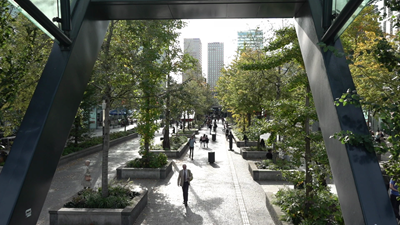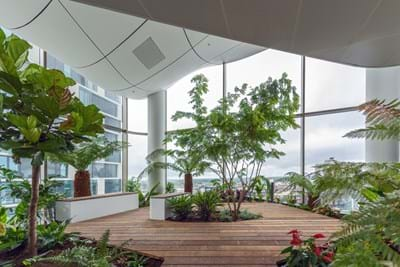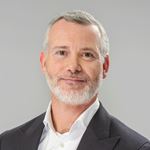- Home EN
- News
- Latest news
- 2021
- Office of the future is iconic, sustainable and well-connected
Office of the future is iconic, sustainable and well-connected
Working from home became widespread during the Covid-19 pandemic, but according to Bas Jochims, Director Dutch Office & Hotel Investments at Bouwinvest Real Estate Investors there will always be a need for offices that offer distinctive social meeting places with excellent credentials in terms of their sustainability, quality and location. Even though some companies put decision-making on new leases on ice during the past 18 months, occupier sentiment is now improving in many countries across Europe, underpinned by strong economic fundamentals.

Are you concerned about the future of the office market?
Bas: “We’re still seeing some uncertainty and hesitancy among occupiers, but broadly speaking the lights are turning green. Sentiment is now changing and we’re seeing larger companies taking decisions again.
The starting point is also very favourable. For example, in the Netherlands, there isn’t as much vacant office space as there was during the Global Financial Crisis. Economic and employment growth forecasts are now very positive for most capitals and large cities across Europe, including our home market, with the notable exception of The Hague. We’re seeing increased demand from financial, IT and other knowledge-based sectors and their focus is on the type of sustainable properties we already invest in, at central, well-connected locations with attractive facilities for business meetings, and a healthy work environment. We will therefore continue to invest in office assets in the big cities.”
The Dutch office market was characterised by record vacancy levels during the Global Financial Crisis. How would you describe it now?
Bas: “Office vacancy in the leading Dutch cities reached double-digit levels around 2013-2014 but have since dropped significantly. Vacancy rates, especially in the best locations, are now very low and loan-to-value ratios are also much healthier than they were a decade ago. A lot of obsolete office space has been transformed since the crisis into hotels and residential, and any vacancy is concentrated primarily in older office stock on B or C locations.
What trends do you see among office occupiers?
Bas: “The office of the future needs to match the brand of its occupier by being very distinctive in terms of its architecture or former use as well as location, especially now that the war on talent is heating up. A good example is our recently opened Central Park office development in Utrecht: the complex is uniquely located right in the heart of the Netherlands so should appeal to a wide variety of companies, including international firms, for whom accessibility is key. The same is true of our recently refurbished WTC in Rotterdam. We also have some good examples of iconic buildings in Amsterdam. Our tenants at the former Citroën buildings in The Olympic Amsterdam include Pon, an international trading company with a focus on mobility, as well as Under Armour, a US sports brand. Both companies chose this location primarily because of its gateway function to the city centre of Amsterdam as well as its proximity to the nearby Olympic Stadium since they identify strongly with sports and mobility.”
What impact will the pandemic have on the future of offices?
Bas: “There’s still a lot of uncertainty among office tenants about how entrenched working from home will remain in the future. That has certainly affected leasing activities in the past 18 months, and we have also seen decision-making postponed. We haven’t seen any large companies downsize their office space in our portfolio, but nobody really knows what the future will hold. What we can say is that in future a mix of long-term and flexible space looks like becoming the ideal combination.

Is Central Park an example of what you see as the office of the future?
Bas: Central Park ticks all the boxes in terms of what occupiers’ demand from a modern office building. It is a high-quality, sustainable property and its location at Utrecht Central Station means it has excellent connectivity. The building also contains the latest technology to facilitate fast communication and greater efficiency and productivity. But what really stands out is its two-story high park located in the middle of the building reaching a height of 45 metres. This green, parklike environment with breakout places and a social hub in the entrance hall is exactly what tenants are looking for. The role of the office is changing: it’s no longer just a work spot, it’s also a meeting place, and first-class assets in prime locations that function as a magnet have become even more relevant post-Covid.”
How is the growing emphasis of occupiers and investors on sustainability and ESG factors affecting your business?
Bas: “This is not a new trend, but we have seen this accelerate since Covid-19. ESG is a key focus area for us as part of our mission to offer real value for life and to invest in assets that generate both a social as well as a financial return. Central Park was intended to be ‘Paris-proof’ - or net carbon zero - from day one and at Bouwinvest we have developed roadmaps to make all our assets emission-free by 2045, five years earlier than the deadline of the Paris Accord. We now know what measures we need to take to reach our environmental goals.
The definition of sustainability is broadening to include a healthy work environment, wellness and lively neighbourhoods – not only in the office market. Increasingly, the central question we ask ourselves when we make an investment is: "for what social challenge can we offer a solution?" Our investments in healthcare and affordable rental housing are good examples of how we aim to answer that question.
Do you have any other examples?
We also see opportunities in social infrastructure, for example in schools. Many municipalities are cash-strapped and find it challenging to maintain and renew their social infrastructure. If we were to take over the ownership of these assets through sale-and-leaseback agreements, we could make the necessary investment and optimise facility management.
These business development plans are still in the early stages, and we see some hesitancy from municipalities. We saw the same pattern a few years ago in the healthcare sector, but we now have a number of projects in this area. Investment in social infrastructure is a good example of how we can deliver solutions and generate both a positive financial and societal return.”


